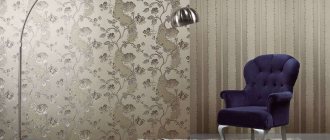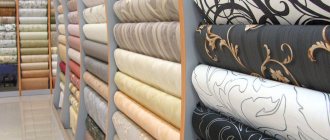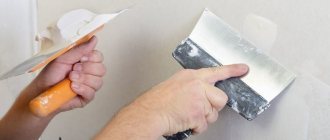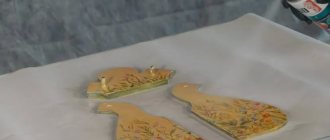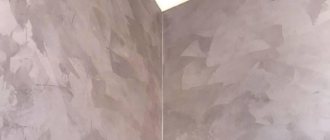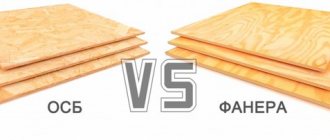When the renovation is completed and the decorative roll finishing materials are glued, the selected pattern and color pleases the eye. Over time, dust and grease settle on the walls, the color fades, and the surface is subject to mechanical damage (scratches, children's drawings, traces of tape). To ensure that the surface of the walls pleases you with its ideal condition for as long as possible, one of the solutions is to coat the wallpaper with varnish.
Varnish for photo wallpaper - why is it needed?
A long service life of the finish and an aesthetic appearance will be ensured by the varnish for photo wallpaper. What situations does it help to cope with and how does it work out in practice? Let's figure it out.
The panel in the kitchen interior is used both for zoning the space, for example, to highlight the dining area, and as a design for the kitchen apron. In both cases, grease stains, splashes of drinks or soup, etc. have every chance to complement the original appearance of the finish. The varnish here acts as a protective barrier, preventing the penetration of contaminants into the inner layer. Just one wet cleaning and the decor is like new again.
The scope of application of photo wallpapers in interior design is wide . With them you can easily turn doors, old furniture and appliances into real works of art. And to make such a finish pleasing to the eye for a long time, photo wallpaper can be varnished. It will protect the edges and corners from abrasions and tears, and fingerprints and dirt will disappear immediately, because now you can wash household items updated with wallpaper.
Coating photo wallpaper with varnish opens up new horizons for design experiments in bathroom design. Picturesque paintings, fantasy patterns and creative installations can now easily take up residence in the bathroom and toilet! Lamination prevents the appearance and development of mold and fungal infections of the finish, the penetration of moisture deep into the coating and its peeling from the surface.
Corridor, bedroom, living room - when purchasing photo wallpaper for these rooms, do not forget to select the option to varnish the photo wallpaper in the order form. Thanks to this, the decor will receive reliable protection from mechanical damage and contamination. Keys, key rings, locks, umbrellas, heels and other accessories and fittings - all these little things will not cause annoying small scratches on the walls! And after creative activities with paints or plasticine, children's fingers can be easily washed with a damp sponge and cleaning agent.
About bright colors. The varnish coating will help keep the color palette of the panel in its original form. This is especially true for pasting walls in rooms on the sunny side. To achieve greater effect and protect the decor from fading, choose printing with UV ink.
Long shelf
This solution is now in trend, and deservedly so - it looks elegant, beautiful and also functional. A horizontal line visually expands the space, and if you paint the wall below and above the shelf in different colors, the effect will be enhanced.
Choose a shelf that is not wide so that you can put small decor, posters and photographs on it. If you are afraid that all this will fall on your head at night, stop on a shelf with a side. If the shelf is very narrow, a curtain string stretched a short distance above it will also cope with this task. On such a design you can even place a book or a laptop (vertically), put small items and hang glasses on a string - you see, you will be able to do without a bedside table.
What varnish should I use for photo wallpaper?
Practical to use, aesthetically pleasing and wear-resistant finish - is this what the result of the renovation work looks like? Much here depends on what varnish you use to cover the photo wallpaper. A transparent composition of optimal consistency should be applied in an even layer, without bubbles.
It is worth considering the combination of materials, the consequences of the chemical reaction of glue and varnish. The wrong choice, as well as applying varnish directly to the glued panel, increases the risk of defects, which will make the decor completely unsuitable. It’s easy to avoid this situation - order laminated photo wallpaper. Entrust such an important task to professionals and admire your decor for many years!
For many years, wallpaper has been widely used in houses and apartments as a finishing material. This is a popular and inexpensive finishing method. Can acrylic varnish be applied to drying oil?
Modern wallpaper should not only be beautiful, but also durable. Unfortunately, their service life is not always long. Therefore, the question of additional coating protection becomes relevant. Can wallpaper be varnished? Experts give a positive answer.
Cabinet or rack
Yes, the closet can be not only on the side of the bed or on the opposite wall, but also above it. These can be just hanging drawers, but a more reliable and useful design is two tall cabinets on the sides and a section between them high above the headboard. We have already talked about this space-saving technique in the article “Wardrobe in a small bedroom.” Instead of a closet behind the bed, there can be a shelving unit - either protruding or built into the wall.
This configuration perfectly fills the wall next to the bed, but usually leaves an empty square between the wall cabinets and the headboard. Bright wallpaper with a pattern or a painting, or maybe a small shelf in this place will be enough. If you also integrate lamps into the wall unit of the closet, the decor will be accentuated and it will be more convenient to read in bed.
Why open the wallpaper with varnish?
Wallpaper is varnished to protect it. So, among the advantages of this operation we can note:
- Moisture resistant. This even applies to paper wallpaper. By treating them with varnish, you can prevent deformation of the coating when water enters. And this allows you to use paper wallpaper in the bathroom.
- Resistance to mechanical damage. The varnish forms a thin but durable film.
- Protection of the top layer. The drawing cannot be erased or damaged in any other way (for example, after sticking tape). In addition, the paint on the wallpaper does not fade when exposed to sunlight.
- Appearance. The surface treated with wallpaper varnish becomes more saturated and shiny.
Method 4
The steam method is one of the most reliable and clean. Use an ordinary iron or steam generator. Steam and moisture dissolve glue perfectly, and old wallpaper comes off quickly and painlessly.
- A regular iron should be applied to old wallpaper through a piece of cotton fabric.
- Wet an old sheet heavily and place it against the wall.
- Iron the fabric at maximum temperature.
- After the old wallpaper begins to swell and peel off, use a spatula or knife.
What can be covered?
An important point: not every type of wallpaper can be treated this way. If we talk about vinyl, these coatings initially have good moisture-repellent properties. You can treat them with varnish, but this will not increase their service life.
And there will be more work during dismantling.
It is also not recommended to use protective varnish on fabric wallpaper. Textile is itself a durable material and resistant to various negative influences. In addition to the fact that applying varnish will not extend the service life, the coating can be easily damaged during processing.
But bamboo wallpaper is often varnished. This material can be treated with any varnish. Varnished bamboo wallpaper will last much longer.
The same applies to cork wallpaper. Non-woven fabrics can also be subjected to this treatment. But the exception is white wallpaper for painting.
They must first be painted. Only after this can a layer of protective varnish be applied. Otherwise, the coating will become transparent and all the flaws on the wall will be visible.
Mostly varnish is purchased for paper wallpaper. They are the ones who undergo protective treatment most often. As practice shows, such wallpaper will be resistant to moisture and mechanical damage. Water-based acrylic varnish for wallpaper, matte, ? Thanks to varnish, you can significantly increase the service life of the coating.
The varnish also allows you to expand the scope of application of paper wallpaper. They can undoubtedly be used in the bathroom and other rooms with high humidity.
Characteristics
Applying varnish first of all involves creating a protective layer on the finishing material, which protects it from unwanted contacts with the outside world. But these are not all the useful properties of this coating:
- After drying and polymerization, the varnish coating perfectly resists moisture, which can be destructive for paper or natural wallpaper.
- You can always wash the wall with a regular soap solution to remove dirt and grease, thereby easily maintaining cleanliness and order.
- The varnish reflects sunlight, thereby protecting the decorative wallpaper from fading. This is a long-known advantage of the material; just remember how long the lining on the balcony retains its original color.
- The strength of the protective layer protects the wallpaper from mechanical influences; now the wallpaper is not afraid of scratches, chips, and dents.
Light walls look beautiful, but quickly get dirty, especially in a nursery
Of course, I would like to ignore the disadvantages of this method of strengthening the finishing material on the wall, but we will talk about them:
- First of all, I would like to note that the varnish adds gloss to the surface of the walls, so minor defects come out. If the walls were prepared well, then such problems will not be visible, even when gluing extra thin paper or photo wallpaper.
- In order to apply varnish to the walls, you need to buy it, which means additional repair costs. Of course, they are not very large compared to the total volume, but they are worth taking into account.
- When drying, the varnish narrows slightly, as a result of which it tightens the wallpaper. In some cases, the physics of this process will allow the wallpaper joints to separate.
If these negative aspects do not bother you, you can safely go to the store for a jar of varnish, we will apply it to the walls.
What varnish should I use to coat the wallpaper?
It is important to use only specialized products. Do not treat with improvised means (for example, hairspray). This will cause unnecessary stains and unevenness on the wall.
Wallpaper varnish VAK A-104 receives a lot of positive feedback. It is excellent for paper coatings.
Materials such as cork are particularly demanding when it comes to varnish. Cork wallpaper has a beautiful appearance, but is prone to damage. Therefore, for the purpose of protection, many resort to varnishing.
You cannot use regular varnish for cork. This will reduce the elasticity of the material and also close the pores through which air passes. Therefore, only the varnish that is intended specifically for cork is used.
Method 3
Use a special wallpaper remover. It is suitable if the wallpaper is glued firmly enough and cannot be easily removed. This product is absolutely harmless to walls and is absorbed into the coating much faster and more efficiently than conventional home remedies.
In addition, this method will significantly speed up the process and save a lot of time.
- Dilute the wallpaper remover powder or gel with the amount of water specified in the instructions.
- Apply the solution to the walls using a roller or sponge.
- Leave to absorb for several minutes or hours (the exact time is indicated on the product packaging).
- The wallpaper will begin to come away from the walls on its own, and you can remove the remains with your hands or use a spatula for particularly difficult areas.
- Cut waterproof wallpaper in advance with a knife or a special device.
- This method is suitable for paper, vinyl and other types of wallpaper.
Varnishing instructions
Let us first note that old wallpaper cannot be varnished. Otherwise, all the flaws on the surface will be visible. Also, before gluing, you need to carefully level the wall. For this, putty is used.
Additionally, the wall is primed for better adhesion and painted with white water-based paint. This will even out the tone of the wall (since the varnish will highlight all the stains and differences in shades). For reliable fixation, it is recommended to add PVA glue to the solution. It is necessary to carefully glue all joints.
If it is non-woven or paper wallpaper, it is primed with a PVA solution before varnishing.
Next, start applying varnish. This can be done using a roller. Acrylic varnish for walls: how to apply video?
You should not use a brush, as it leaves noticeable and unsightly streaks. Varnishing is done in two layers. In this case, you should wait until the previous one dries completely.
This will take about a day.
Cosmo recommends
The most trendy shoes of spring 2020 for wet weather: which models to wear in the rain?
How to Safely Remove Eyelash Extensions at Home
Gluing new wallpaper over old ones is madness and a relic of the past. In order not to repeat the mistakes of your ancestors, get rid of outdated wall coverings and only then start gluing. There are several convenient and simple methods that are quite realistic to do with your own hands without outside help. This material contains the top useful life hacks, armed with which you can easily remove paper, vinyl and washable wallpaper with your own hands.
What's next?
An important stage when treating walls with varnish is drying. It should occur at temperatures from 5 to 30 degrees above zero. It is also unacceptable for air humidity to be more than 80 percent. Experts do not recommend speeding up the drying time of the surface using a hairdryer.
After this, you can polish the varnish. Further, the coating does not require attention, as it has antistatic properties. If there is heavy contamination, it is enough to treat the surface with a damp cloth.
To remove greasy marks, first dip it in a soap solution.
Method 1
Suitable for old wallpaper that barely holds on and comes off on its own in some places. Pull the top edge, and pry off the stubborn parts with a spatula or knife, try to remove carefully so as not to crumble the canvas into small pieces. Remove the remnants of old wallpaper using a spatula and a sponge dipped in warm soapy water.
How to remove varnished wallpaper?
There are several ways to remove old varnished wallpaper:
- Using sandpaper. But since the amount of work will be large, it is recommended to use a tool. As an assistant, use a grinder with a brush attachment. This attachment consists of numerous pieces of wire and is capable of quickly removing a layer of wallpaper on the wall. However, not everyone uses this method, since after treatment the wall must be puttied.
- Using special compounds. To remove wallpaper, you can use the softening compound Quelyd Dissoucol. After applying it to the surface, go over it with a needle roller. What surfaces can acrylic varnish be applied to? This way, the active substances will penetrate inside the wallpaper and reduce the adhesion of the material.
Method 2
This method leaves less dust and dirt.
- Wet the wallpaper with water and dish detergent, wait until the canvas is thoroughly saturated with moisture.
- It is important that the glue softens and begins to come off along with the pieces of wallpaper. You need to remove it 20-30 minutes after applying the liquid.
- Use a spatula or knife to make scraping off soggy pieces of wallpaper easier.
- For wallpaper with a moisture-repellent coating, use a perforating roller.
- Remove pieces of old wallpaper especially carefully near sockets and switches.
- For the greatest effect, you can add laundry soap or 9% vinegar to the water. And for very durable waterproof wallpaper, use fabric softener diluted in a bucket of water.
- After finishing work, wipe the walls with a clean cloth.
Interesting objects
Have you found an art object that strikes your imagination or an item that is extremely dear to your heart? Perhaps his place is above the bed.
Several commonly found wall objects: a panel with fresh flowers, branches, panels or curtains with lighting, compositions of mirrors and a half-canopy.
Accent coating
If you are not a fan of objects hanging over the bed and are generally a minimalist, then you can decorate the wall simply by highlighting it with a different color or material. Moreover, you can make the entire wall an accent, or you can only make part of it - along the borders of the bed. It looks interesting when such a strip goes to the ceiling or even to the opposite wall.
Sophisticated patterned wallpaper that easily dominates the space, or bright paint will find its place in this area. The wall behind the bed can be decorated with a wooden panel or imitation brick - by any means that harmonizes with your interior. An alternative is to use patterns made using a stencil or interior stickers. More about accent walls in these posts:
